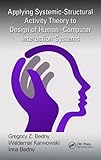Applying systemic-structural activity theory to design of human-computer interaction systems / Gregory Z. Bedny, Waldemar Karwowski, Inna Bedny.
Material type: TextSeries: Publisher: Boca Raton : CRC Press, 2015Edition: 1stDescription: 1 online resource : illustrations (black and white)Content type:
TextSeries: Publisher: Boca Raton : CRC Press, 2015Edition: 1stDescription: 1 online resource : illustrations (black and white)Content type: - still image
- text
- computer
- online resource
- 9781482258059 (PDF ebook)
- 004.019 23
| Item type | Current library | Call number | Status | Date due | Barcode | |
|---|---|---|---|---|---|---|
| E-Resources | Main Library E-Resources | 004.019 B412 (Browse shelf(Opens below)) | Available | E001963 |
Browsing Main Library shelves, Shelving location: E-Resources Close shelf browser (Hides shelf browser)
Includes bibliographical references and index.
Chapter 1: Concept of Self-Regulation Outside of Activity Theory -- Chapter 2: Concept of Self-Regulation in Activity Theory: Psychophysiology and Psychophysics Perspectives -- Chapter 3: Concept of Self-Regulation in Systemic-Structural Activity Theory and Strategies of Task Performance -- Chapter 4: Thinking as a Self-Regulative System and Task Analysis -- Chapter 5: Attention as a Self-Regulative System -- Chapter 6: Cognitive and Behavioral Actions as Basic Units of Activity Analysis -- Chapter 7: Morphological Analysis of Work Activity during Performance of Human-Computer Interaction Tasks -- Chapter 8: Quantitative Assessment of Task Complexity Computer-Based Tasks -- Chapter 9: Complexity Evaluation: : Practical Example -- Chapter 10: Introduction to Human Reliability Assessment -- Chapter 11: Systemic-Structural Activity Approach to Reliability Assessment of Computer-Based Tasks -- Chapter 12: Formalized and Quantitative Analysis of Exploratory Activity in HCI Tasks.
Human-Computer Interaction (HCI) is an interdisciplinary field that has gained recognition as an important field in ergonomics. HCI draws on ideas and theoretical concepts from computer science, psychology, industrial design, and other fields. Human-Computer Interaction is no longer limited to trained software users. Today people interact with various devices such as mobile phones, tablets, and laptops. How can you make such interaction user friendly, even when user proficiency levels vary? This book explores methods for assessing the psychological complexity of computer-based tasks. It also presents methods of qualitative and quantitative analysis of exploratory activity during interaction with a computer.
Description based on CIP data; item not viewed.
There are no comments on this title.








